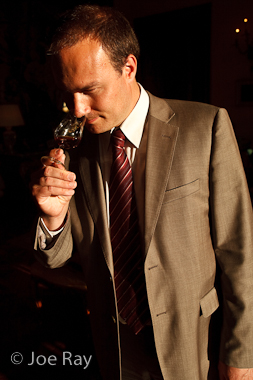The Art of The Blend - Cognac
Spring 2010 - Centurion Magazine

Using three eaux de vie ranging in age from six to thirty years, a group of people in an antiseptic tasting room try their hand at creating emotion in a bottle.
Rémy Martin cellar master Pierrette Trichet watches over the group, pokes her nose in a student’s glass and frowns. “Smells a little old and a little expensive,†she says. Translation? Back to the drawing board.
The exercise gives a microscopic sense of what a cellar master (known here as a maître de chai) does every day as they work to blend the contents of thousands of barrels to create consistent cognacs year in and year out. I draw a mental comparison between the production process of Scotch whisky and cognac but quickly learn that the former has a Bauhaus-like pragmatism next to the latter’s Monet-style subtleties. Besides, this is France, land of grapes and mind-boggling bureaucracy; this will not be a simple process.
The crib notes for making cognac involve hundreds of producers from multiple, distinct regions who use the ugni blanc grape (entre autres) to make wine, which is passed to a network of distilleries, where they create the raw eau de vie. At 140 proof, you’re lucky if you get a whiff of something reminiscent of an Atomic Fire Ball before it blows out your nose.
Next, the mellowing process begins by using oak barrels of three different ages. These barreled eaux de vie are often blended and re-barreled in a lifespan that can last more than a century before a final blend and bottling.
What’s Trichet’s trick? Taking it one glass at a time. Demonstrating with the six-year in front of her, she detects notes of fresh fruit, almond and hazelnut while the
thirty-year has prune and walnut smells.
“You’ve got to memorize what’s in them,†she says simply.
She re-smells both, pulling out characteristics she’ll use as mental waypoints to remember this particular batch and give her an idea of what to do with it in the future. Still, the prospect of a warehouse full of barrels is a bit overwhelming.
“We taste them all. Every batch. Every year,†says Benoît Fil, maitre de chai for Martell. “The key to our work is tasting everything, every year. From those notes, I can tell what we’ll need to do with each one.†To this end, Fil works with a small tasting committee who taste a palatable number of eaux de vie every day.
What they learn is plugged into what he calls a ‘matrix’, the work of generations of blenders and tasters that charts the progress of each batch, which gives an idea of what they might be like in the future and how to blend them to create consistent products.
Science, however, only goes so far.
“When you blend, one plus one can make two, but it can also make three, five, ten or twenty,†says Laurent Lorenzo, Hennessy’s director of research referring to the quality of the final product. “No chemical analysis can tell you ‘This is good’ or ‘This is exceptional.’ Only tasting can do that.†For someone with a job this technical, there’s a refreshing amount of humanity in Lorenzo’s approach, and after tasting five eaux de vie, he smiles. “These are all beautiful creatures,†he says, always referring to them in the French feminine and consistently shunning a technical description for something on a more emotional level. “You can be loud and persistent,†he says with a dismissive shrug, while defining what he’s looking to put in a bottle. “But being delicate and persistent – that’s another story.â€
Click here to see the article as a PDF.